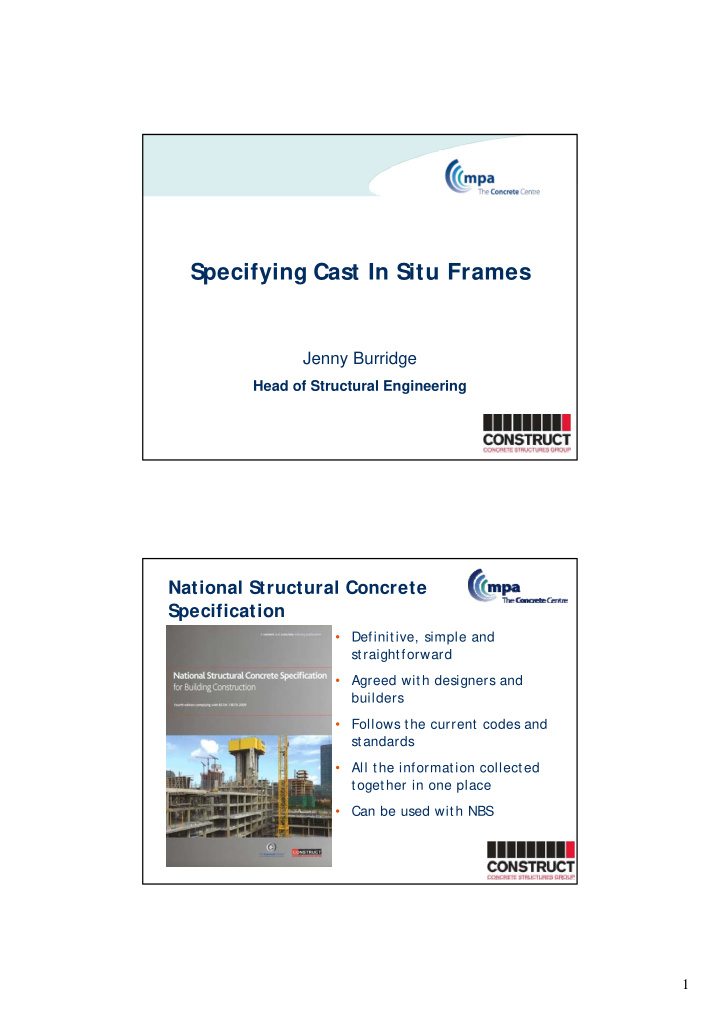



Specifying Cast In Situ Frames Jenny Burridge Head of Structural Engineering National Structural Concrete Specification • Definitive, simple and straightforward • Agreed with designers and builders • Follows the current codes and standards • All the information collected together in one place • Can be used with NBS 1
2
Execution Specification for Concrete From the Design Team’s point of view: • What is wanted – functional or a beautiful, long lasting building • How do you get there? What do you ask for? • Construction – fresh concrete properties • Construction – formwork, location and tolerances • S trength – concrete and reinforcement properties • Durability – concrete properties • Appearance – while having the right fresh properties, strength and durability 3
Execution specifications: BS EN 13670 & NSCS Types of Finish as BS EN 13670 Types of Finish Hierarchy of Tolerances Hierarchy of Tolerances Green Issues 4
• Part 1 S tandard S pecification (10 sections) • Part 2 Proj ect S pecification: (2 sections) • Part 3 Guidance • Colour co-ordinated! NSCS Part 1 This part contains the standard specification clauses 5
6
7
Edition 4 NSCS 1 Scope 2 Bibliography 3 Definitions 4 Execution Management 5 Falsework and Formwork 6 Reinforcement 7 Prestressed Concrete 8 Concrete and Concreting 9 Precast Concrete 10 Geometric Tolerances NSCS Part 2 This part should be filled in for each proj ect. The following can be specified: • Concrete types • Concrete finishes • Formwork • Other materials • Responsible sourcing 8
NSCS Part 3 9
“Sustainable construction – Cement The specification must achieve a balance, which ensures workability, durability, appropriate rate of strength gain and, for visual concrete, the required colour.” Finishes: • Basic • Ordinary (equivalent to Type A) • Plain (equivalent to Type B) • S pecial • Reference Panels for Ordinary and Plain finishes are located around the country 10
Execution Management • The flow of information is essential on any construction proj ect. A good proj ect needs well managed information • Table P1.3 has been retained to cover issue of drawings and documents • Table P1.4.2 has been added – indicating when certification and checking information is to be provided Drawings & calculations (P1.3) 11
Execution documentation (P1.4.2) Prestressed Concrete • The NS CS now incorporates the CARES model prestressing specification • The document is coordinated with the ENs for grout and the ETAG requirements for stressing 12
Tolerances • Tolerances MUS T be thought about carefully as there is no fixed system that can be applied to give the “ right” answer every time. • This section can be read as “ stand alone” in the NS CS as it brings together normative and informative EN tolerances • Tolerances are “ right” for a typical building and need more care in other cases. 13
Rotational tolerance Concrete Finishes • The BS 8110 types of surface finish A, B & C with finish classes 1, 2 & special have been replaced. • BS EN 13670 has basic, ordinary, plain and special concrete finishes for formed and unformed surfaces • For formed surfaces the definitions are developments of the BS 8110 descriptions for Types A and B and NBS descriptions of plain smooth and fine smooth finishes. • The “ plain” is intended to be suitable as an exposed finish almost “ as struck” , but not a super quality architectural finish which must be a special. 14
15
Concrete Specification • Teamwork is the key – only with all of the team engaged will the client get the right result • A great specification can be spoilt by poor application • A poor specification can produce a great result – sometimes even when this is not required Thank You Any Questions 16
Recommend
More recommend